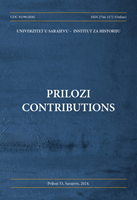Elektrifikacija kao preduvjet opšteg blagostanja naroda i zemlje. Prvi planovi elektrifikacije DFJ / FNRJ
Electrification as Prerequisite for Progress of People and Country. The First Electrification Plans of Democratic Federal Yugoslavia / Federal People’s Republic of Yugoslavia
Author(s): Dženita Sarač RujanacSubject(s): National Economy, Energy and Environmental Studies, Economic history, Social history, Economic development, WW II and following years (1940 - 1949), Socio-Economic Research
Published by: Institut za istoriju
Keywords: Yugoslavia; renovation and construction; electric power; electrification; plans;
Summary/Abstract: After the end of the Second World War, the Yugoslav leadership, under conditions of strict centralization and revolutionary statism, insisted on accelerated industrialization and electrification as a key strategy for the development of the state and the progress of society. At the same time, the production of electricity was very important as an economic branch for the development of which there were great, natural predispositions, significant hydro potential and enviable coal reserves. At the same time, electricity was necessary for strong industrial development, as spiritus movens and “the most powerful lever in the industrialization of the economy”. Wide electrification, which was supposed to bring electricity to every household and farm, was presented as a prerequisite for a radical change in the way of life of the inhabitants and their everyday life, as a guarantee of the imminent elimination of economic and cultural decadence. It was interpreted as a universal need, while the daily press often wrote about the numerous advantages that electricity brings. Special attention was paid to the experience of the electrification of the Soviet Union, which was a role model in this, as in everything else in those post-war years. In this paper, we look at the issue of reconstruction during the last war years and the primary post-war reconstruction of Yugoslavia, which included the rebuilding and rehabilitation of important economic facilities, especially the power plants. We focused on the original electrification plans, which projected the renewal of existing production capacities, the extension of the started facilities as well as the construction of large thermal power and hydropower plants which were supposed to be the key producers of the necessary driving power for accelerated economic development. These drafts, reports and plans were created by order of the Ministry of Industry of the Democratic Federative Yugoslavia, i.e. Federative People’s Republic of Yugoslavia (FNRJ). They were created at a time of intense centralization and the construction of a cumbersome administrative apparatus, which was not carried out without resistance and criticism. We paid special attention to the Electrification Plan of Eng. Jerko Jerić at the beginning of 1946, who planned the development from 1946 to 1954 and the construction of ten hydropower plants (Dravograd, Mariborski otok, Bogatići, Vinodol, Vlasina-Vrla, Vrulja-Cetina, Jajce-Pliva, Bisko-Cetina, Rama-Neretva and Perućac na Drini) and seven thermal power plants (Velenje, Rajhenburg, Doboj, Kakanj, Kostolac, Soko and Vreoci). This Jeri’s plan was severely criticized and was not accepted, but it served as a justified basis for the general electrification plan from 1947, which became part of the first five-year National Economic Development Plan of the FNRJ.
Journal: Prilozi
- Issue Year: 2024
- Issue No: 53
- Page Range: 339-371
- Page Count: 33
- Language: Bosnian

